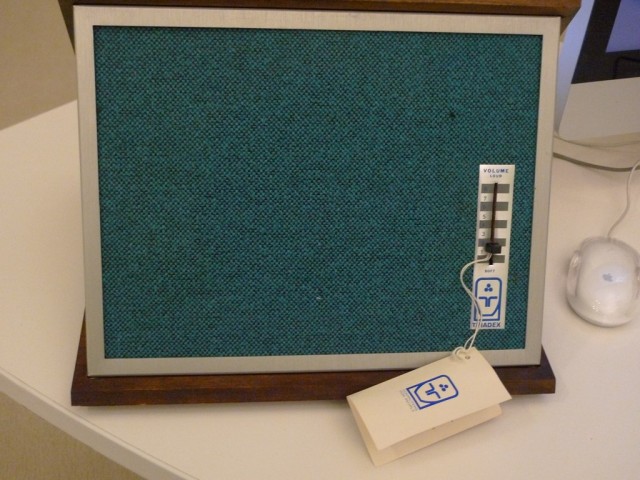
The one sequencer that you can see in a computer museum. The original Triadex Muse. Photo (CC-BY) Michael Hicks.
The 70s were one heck of a groovy time. When they weren’t postulating theories about the very underlying essence of all physical reality being reduced to computational models, pioneering AI scientists were … creating weird music sequencers? Seriously?
The Singularity will be brought to you by Giorgio Moroder, perhaps?
Yes, as we saw earlier this week, AI legends Edward Fredkin and Marvin Minsky somehow managed to take their research in philosophy, digital physics, and cognitive science, and make a weird box that most definitely is capable of blinking lights and making sequences of bleeps.
The Triadex Muse really seems like something you’d find on the deck of the early Starship Enterprise. (Live set tonight in Panorama Bar, Nyota Uhura.) Representing the shift registers that store the sequences of notes, there are series of light-up LEDs along the side of the faders. As those lights chase one another, you can see the variations in melodic patterning that keep the Muse spitting out new tunes.
Sonically, the devices are primitive; basic circuitry produces the sound. But the algorithmic production of music is unique. This was no sci-fi prop: it was a working machine capable of improvising melodies in the days when computers were things in giant rooms, one of the first digital logic machines of its kind, and one of the first-ever digital sequencers. The interest in a hardware recreation from Future Retro we saw yesterday demonstrates that the basic idea can still dazzle music geeks.
And the hardware itself is gorgeous: a brushed-metal triangular prism, faced only by a series of tall faders and lights. Three hundred bucks in 1972 dollars means this would be about US$1700 today (and you’d pay about as much on eBay). But that’s a steal: a Minimoog from two years earlier cost about US$9000 in modern currency.
But it’s partly the fact that this came from Minsky and Fredkin that makes it so interesting. In nerdy fields like reversible computing and cellular automata (Fredkin), neural networks, head mounted displays, and even the LOGO Turtle (Minsky). They were big enough to make their way into pop culture. Minsky was an advisor on the movie 2001; Arthur C. Clarke in the book even fictionally credits Minsky and >I.J. Good with the self-replicating intelligence that created HAL. (If a computer ever does throw you out an airlock, you’ll know Clarke was right, and you can curse Minsky with your dying breath.) Fredkin gets his own fictional apocalypse: supposedly War Games‘ Professor Stephen Falken is supposedly modeled on him.
This should all come as a bit of a challenge, though. Electronic music’s role in early technology, from the dying song of HAL (Max Mathews) to futuristic models of AI here, means that the resurgent interest in vintage tech can give our futurism a better grounding in real history. It makes electronic music a fantastic teaching tool, and allows us to discover the artifacts of the past that can be futuristic now.
But I think computer music can do more to engage the latest bleeding edge in computer science, cognition, physics, and other fields (even science fiction). Much as I love the 70s, too, that means we can’t only recreate the past. I hope electronic music remains a field where the biggest innovators feel at home. Time for a new rave for the future.
And for inspiration, maybe our post-digital world might consider the radical thoughts of the digital philosophy movement, not only how much we love warm, fuzzy old analog gear.
Create Digital Reality – Create Digital Everything. Indeed. Someone was really staring at those cellular automata patterns for a while. Mind… blown.
Thanks to Kim Cascone for the video.
More images from Lindsey Mysse / @lindseymysse show just how clean the form factor of this was. And perhaps most unique of all, check the speaker screen. The notion was, you’d set the faders, put on the screen, and use this as your home stereo device. (Huh. Okay, that didn’t quite catch on.)
And here’s the fantastic light show add-on.

